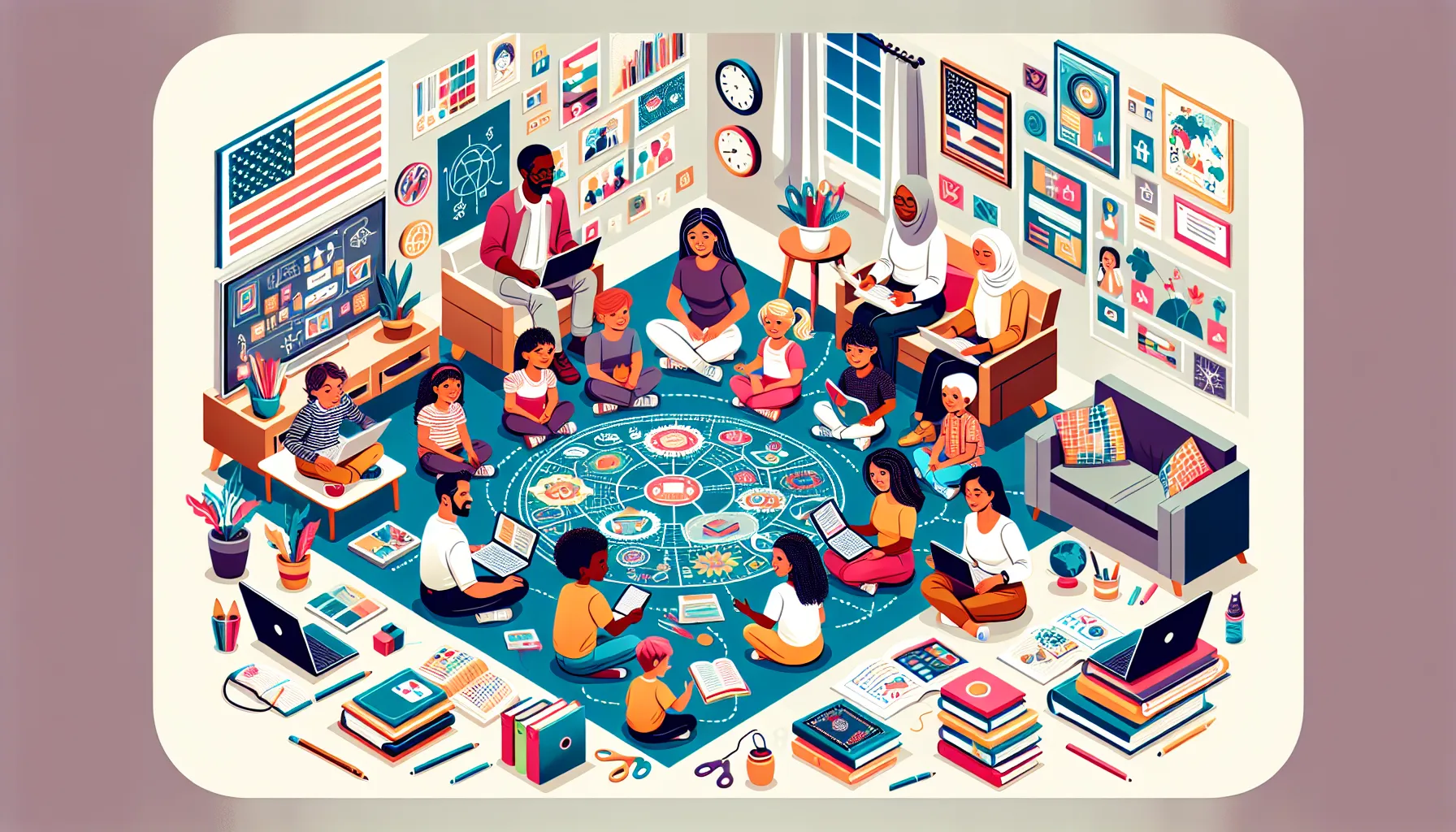
Key Takeaways
- Free homeschool curriculum options empower families to provide quality education without financial strain, offering various resources suitable for different subjects, grade levels, and learning styles.
- These curriculums promote flexibility, allowing parents to adapt lessons to their children’s pace and preferred learning methods for a personalized educational experience.
- Resources include free online programs, printable materials, and open-source textbooks, covering both core subjects and creative areas like art and music.
- Choosing the right curriculum involves understanding a child’s learning style, evaluating resource quality, and incorporating interactive, engaging activities to foster interest.
- Common homeschooling challenges, such as managing time, keeping children motivated, or avoiding isolation, can be addressed with planning, diverse teaching methods, and community involvement.
- By leveraging free homeschool options, parents can create an enriching, cost-effective learning environment tailored to their child’s growth and success.
Homeschooling offers families a chance to create personalized learning experiences, but finding quality resources without breaking the bank can feel overwhelming. Many of us worry about balancing educational needs with affordability, and that’s where free curriculum options come in. They provide a practical solution for families wanting to give their children a solid education without the high costs.
Have you ever wondered if free resources can truly meet your child’s learning needs? The good news is there are plenty of options that cater to different subjects, grade levels, and learning styles. From comprehensive programs to supplemental materials, these resources empower us to craft an effective and engaging homeschool experience. Let’s explore how these options can simplify our journey and help us focus on what matters most—our children’s growth and success.
Benefits Of Using Free Homeschool Curriculum Options
Free homeschool curriculums offer families financial relief. With no cost involved, parents can allocate resources to other essential areas, such as extracurricular activities or educational supplies that enhance learning.
These curriculums provide flexibility. Families can select programs that fit their schedules and adapt to their children’s learning pace. This personalized approach fosters a deeper understanding of subjects.
Access to diverse materials is another advantage. Many options include core subjects like math, science, and history, alongside creative areas such as art and music. This variety broadens educational experiences and keeps learning engaging.
Using free resources can encourage creativity in teaching methods. By integrating games, interactive tools, and hands-on activities, learning becomes an enjoyable process for both parents and children.
Many free options cater to different educational philosophies. Parents can explore styles like classical, Charlotte Mason, or unit studies to find those aligning with their family’s values and goals.
Have you found cost-effective resources that support your homeschooling journey? Free curriculums make that possibility accessible while maintaining quality and adaptability.
Top Free Homeschool Curriculum Options

Free homeschool curriculum options make it possible to create engaging and effective lessons without stretching budgets. With various resources available, families can choose tools that suit their educational needs and teaching styles. What learning methods work best for your children?
Online Programs
Web-based resources give access to comprehensive curricula across subjects and grade levels. Many sites offer structured lessons, interactive videos, and quizzes to help students grasp concepts at their own pace. Some platforms even incorporate activities like virtual labs or coding challenges to enhance engagement. These programs accommodate a variety of learning preferences, making them ideal for diverse educational setups.
For instance, specific platforms provide free access to full K-12 curricula, covering core topics like math, science, language arts, and history. Other sites specialize in creative subjects like art or music, bringing variety to daily learning. Do your kids enjoy interactive tools that combine education with technology?
Printable Resources
Print-friendly lessons, worksheets, and activity packs serve families preferring hands-on materials. These resources allow parents to create offline study plans—ideal for cutting screen time or reinforcing skills through repetition. Many sites categorize them by grade, making it effortless to locate suitable content.
Examples include detailed math exercises designed to solidify fundamental skills or science experiments with step-by-step instructions. Printable reading comprehension sheets also support language development in younger learners. Can you imagine combining these tools with daily lessons to make learning both structured and fun?
Open-Source Textbooks
Open-source textbooks provide cost-free alternatives to traditional books while maintaining academic rigor. These digital books often align with state curriculums, covering everything from algebra to world history. Editable formats let parents adapt content to their child’s learning needs.
Many open-source texts also include practice problems and in-text explanations, helping students build a deeper understanding of core concepts. Sciences, literature, and advanced mathematics are among the frequently available subjects. Would access to flexible, no-cost textbooks simplify your homeschooling days?
Tips For Choosing The Right Free Homeschool Curriculum

Selecting the right free homeschool curriculum plays an important role in creating a productive and enjoyable learning experience. By considering key factors, parents can craft an educational plan that meets their child’s needs and goals.
Consider Your Child’s Learning Style
Every child learns differently, so it’s important to identify what methods suit them best. Some children thrive with visual aids like videos and diagrams, while others excel through hands-on activities or auditory materials, such as narrated lessons or discussion-based learning. Is your child more independent, or do they prefer guided instruction? Understanding these patterns helps narrow down curriculums that resonate with their strengths and needs.
Evaluate Available Resources
The variety of free resources can feel overwhelming, but focusing on core priorities simplifies the process. Look for programs offering subjects relevant to your child’s grade level and educational goals. Are there downloadable lesson plans, online interactive tools, or printable worksheets that match what you’re looking for? Consider platforms that combine multiple subjects to save time and streamline planning. Pay attention to certification or alignment with existing academic standards if state requirements are a consideration.
Incorporate Flexibility And Creativity
Flexibility in a curriculum supports personalized learning and fosters creativity. Seek programs that allow freedom to assign topics at your child’s pace. Creative components—like educational games or project-based tasks—make lessons engaging and memorable. Can you integrate outdoor activities, arts, or experiments to supplement their learning? A balance between structure and exploration encourages curiosity and keeps the experience enjoyable for both learners and educators.
Common Challenges And How To Overcome Them
Homeschooling offers flexibility and personalization, but obstacles can arise. Recognizing these challenges helps families address them effectively and maintain a smooth educational journey.
1. Balancing Time Commitments
Managing teaching responsibilities alongside household tasks or work presents a common hurdle. Establishing a schedule with clear time blocks for lessons, chores, and work can streamline daily tasks. Using visual aids, like calendars or planners, keeps priorities visible and manageable. Incorporating independent activities, such as educational games, can also engage children while we focus on other responsibilities.
2. Finding Comprehensive Resources
Identifying free, quality materials suitable for all subjects can feel overwhelming. To address this, we can classify topics into core areas, like math and language arts, and supplemental topics, such as art or science experiments. Starting with trusted library collections, printable worksheets, or open-access educational platforms can save time and expand resource options. Seeking recommendations from homeschool communities also simplifies the search.
3. Keeping Children Motivated
A lack of interest in lessons can slow progress. Mixing traditional methods with interactive tools makes learning enjoyable. For instance, pairing video lessons with hands-on projects keeps children engaged. Regularly celebrating achievements, whether small or large, builds confidence and motivation.
4. Avoiding Isolation
Homeschooling may reduce children’s social interactions. Organizing playdates, joining co-ops, or participating in extracurricular activities creates opportunities for connection. Online forums or virtual interest groups can also provide a platform for interaction when in-person options are limited.
5. Adapting To Learning Styles
Every child learns differently, but adapting teaching methods might seem challenging. Observing how a child responds to various activities, like reading, visual presentations, or physical engagement, helps identify strengths. Rotating between approaches across lessons ensures a well-rounded educational experience.
6. Staying Consistent
Consistency can be impacted by disruptions or distractions. Creating a dedicated workspace free of interruptions fosters focus during study hours. Using structured, flexible curriculum options prevents gaps in learning without being overly rigid.
7. Assessing Progress Without Formal Testing
Without standardized tests, tracking development may feel unclear. Emphasizing regular check-ins, like reviewing completed work or informal quizzes, provides clarity on progress. Keeping a portfolio of projects and assignments also highlights improvements over time.
By addressing these challenges proactively, we create a positive homeschool experience that supports both academic goals and personal growth.
Conclusion
Homeschooling doesn’t have to be overwhelming or expensive. With the abundance of free curriculum options available, we can confidently provide our children with a rich and personalized education that fits their unique needs. These resources not only ease financial strain but also open doors to creativity, flexibility, and meaningful learning experiences.
By exploring diverse materials and embracing adaptable teaching methods, we can create an engaging and supportive environment where our children thrive. The journey may come with challenges, but with the right tools and mindset, we’re equipped to navigate them successfully. Homeschooling can be a rewarding experience for the entire family, and free resources make it more accessible than ever.
Frequently Asked Questions
What are the benefits of using a free homeschool curriculum?
Free homeschool curriculums provide cost savings while offering a wide range of resources for various subjects and grade levels. They offer financial relief, flexibility, and the ability to tailor education to your child’s learning style, ensuring an engaging and personalized learning experience.
Are free homeschool resources effective?
Yes, free homeschool resources can be highly effective when chosen carefully. Many options are developed by educational experts and offer interactive content, downloadable materials, and structured lesson plans that align with learning goals.
How do I choose the right free homeschool curriculum?
Consider your child’s learning style, interests, and strengths. Evaluate the resource’s content quality, adaptability, and alignment with your educational goals. Experiment with a few options to see which works best for your family.
Can I teach all subjects using free resources?
Yes, free resources often cover a wide range of subjects, including core topics like math, science, language arts, and history. Many also include creative subjects like art, music, and coding, ensuring a balanced education.
Are there free online homeschool programs available?
Yes, many websites offer free online homeschool programs with interactive lessons, videos, quizzes, and assignments. These platforms often provide structured courses suitable for various grade levels.
How can I keep my child motivated while homeschooling?
Incorporate interactive activities, hands-on projects, and games into lessons. Set clear goals, celebrate progress, and provide a dedicated and organized workspace to maintain focus and enthusiasm.
What if my child has a unique learning style?
Free homeschool curriculums often cater to different learning styles, such as visual, auditory, and hands-on methods. You can customize these resources to suit your child’s specific needs and preferences.
How can I balance homeschooling with other responsibilities?
Create a clear schedule, set realistic goals, and involve your child in planning. Use flexible homeschool resources that fit into your routine, and consider dedicating specific times for uninterrupted learning.
What can I do to prevent isolation during homeschooling?
Organize social activities, join homeschool co-ops, participate in community events, and encourage interactions with peers through group projects, sports, or extracurricular activities.
How do I track progress without formal testing?
Use informal assessments like quizzes, portfolio reviews, and project-based evaluations. Regularly review your child’s work, provide constructive feedback, and ensure they are meeting educational milestones.

